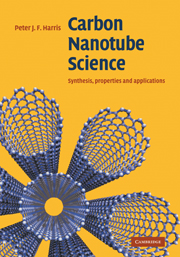Book contents
- Frontmatter
- Contents
- Preface
- 1 Introduction
- 2 Synthesis I: arc- and laser-vaporization, and heat treatment methods
- 3 Synthesis II: catalytic chemical vapour deposition and related methods
- 4 Purification and processing
- 5 Structure
- 6 Physical properties I: electronic
- 7 Physical properties II: mechanical, optical and thermal
- 8 Chemistry and biology of nanotubes
- 9 Carbon nanotube composites
- 10 Filled and heterogeneous nanotubes
- 11 Probes and sensors
- 12 Conclusions
- Name Index
- Subject Index
12 - Conclusions
Published online by Cambridge University Press: 20 May 2010
- Frontmatter
- Contents
- Preface
- 1 Introduction
- 2 Synthesis I: arc- and laser-vaporization, and heat treatment methods
- 3 Synthesis II: catalytic chemical vapour deposition and related methods
- 4 Purification and processing
- 5 Structure
- 6 Physical properties I: electronic
- 7 Physical properties II: mechanical, optical and thermal
- 8 Chemistry and biology of nanotubes
- 9 Carbon nanotube composites
- 10 Filled and heterogeneous nanotubes
- 11 Probes and sensors
- 12 Conclusions
- Name Index
- Subject Index
Summary
Few materials can have been as intensively studied as carbon nanotubes. As a result of the enormous amount of work carried out on these structures since 1991, we now have a wealth of information on their electronic, mechanical, thermal, optical and other physical properties. We know how to attach things to the outside of tubes and to put things inside. We can manipulate nanotubes into defined arrangements and incorporate them into polymer, ceramic or metal matrices. At present, however, there are still relatively few nanotube-containing products on the market. The few commercial products that have emerged are in highly specialized areas such as AFM tips. Perhaps the most commercially significant application of nanotubes to date has been as components of lithium ion batteries, although these employ relatively poor quality catalytically-produced MWNTs. It would be fair to say, then, that carbon nanotubes have not yet fulfilled their potential. The main reason for this is quite simple: they are still far too expensive. The price of single-walled nanotubes is currently around $100 per gram, compared with about $30 per gram for gold. Clearly there is still much work to be done in improving the quality and yield of nanotube production.
In this final chapter, a brief and subjective summary is given of some of the highlights of carbon nanotube research. Some comments are then made on the areas where progress still needs to be made.
Highlights of carbon nanotube research
Any list of classic papers on carbon nanotubes would probably have to begin with Sumio Iijima's 1991 letter to Nature (12.1).
- Type
- Chapter
- Information
- Carbon Nanotube ScienceSynthesis, Properties and Applications, pp. 289 - 295Publisher: Cambridge University PressPrint publication year: 2009

